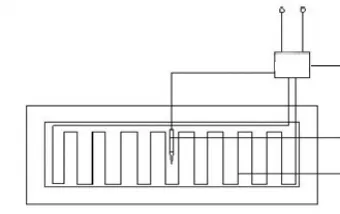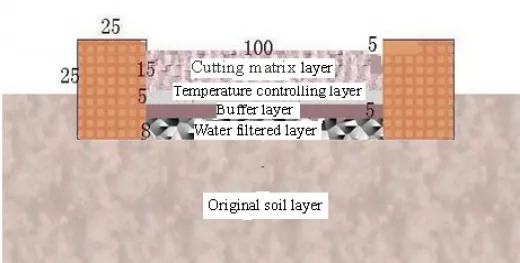The Key Technology of Cutting Propagation
for Camellia reticulata
Yang Yuexian1, Wang Zhonglang*2, Duan Anan3, , Dong Li1, Gao Yuanhua1
1Chuxiong Agricultural school of Yunnan, Chuxiong 675000, China
2 Kunming Institute of Botany, Chinese Academy of Sciences, Kunming 650204, China
3Southwest Forestry University, Kunming 650224, China
* Author for correspondence, e-mail: wang@mail.kib.ac.cn
Introduction
The species C. reticulata is a famous ornamental plant in the world. M.P.Wilder (1835) wrote a first report to the western world, cited in Amer. Gardener’s Mag.: “This is by far the most splendid of the genus that has been yet introduced. The flowers are remarkably handsome… and when expanded measure no less than 5.5 inches in diameter. It is more difficult to propagate than any other of the camellias…” Traditionally, C. reticulata was reproduced by approaching grafting; in recent years, cleft grafting has also been used to propagate new plants. But, as J. Nuccio said in 1978, J. Nuccio (1978) “A fine, new, distinctvariety that performs well but must be reproduced through grafting will never reach great popularity in the trade. Camellias that strike root easily by vegetative cuttings are the true money makers for nurserymen.”
In this paper, an effective cutting propagation system was introduced to all ICS members for propagation purpose.
Methods and Results
Building cuttings bed
After many years of experimenting, the cuttings bed should be 38cm deep (25cm above the ground), 100 cm wide, 1200cm long. Layers from bottom to top of the bed are: the 1st layer, water filtered layer, 8cm thick, filled with1-4cm pieces of bricks, the biggest bricks at the bottom and the small ones at top. The 2nd layer is buffer layer which is 5cm thick filled with mountain sand. The 3rd layer is a temperature controlling layer 5cm thick in total, which consists of 3cm sawdust, covered with 2 cm of mountain sand, and then paved heating wire (Fig.1). The 4th layer is cuttings media layer, 15cm thick (Fig.2).
 T/H Controller
T/H sensor Wire heater |
Fig.1 Ground heating wire paving schematic diagram

Fig. 2 Schematic diagram of cuttings bed
Cutting media
Based on literature reviews and filed investigations of the soil condition at Chuxiong, Dali and Tengchong where Camellia reticulata grows, we chose volcanic soil media, 1/2 volcanic soil with 1/2 red soil and clay media. Test result showed the optimal media for Camellia reticulata cuttings is the equivalent mixture of 1/2 volcanic soil and 1/2 red soil.
Environment of cuttings
To built the greenhouse, we set up a 50cm high shed above the cuttings bed, covered first with plastic film (4S), then two layers shading net (shading rate is 50%); we installed the temperature and humidity controller outside the cuttings bed to keep the temperature between18 to 30℃, RH above 80%, and the cutting media temperature about 20℃ (Table 1).
Table1 Microenvironment controlling of cuttings beds of Camellia reticulata
|
Items |
Media Temperature(℃) |
Air Temperature(℃) |
Relative Humidity (%) |
Light Condition |
|---|---|---|---|---|
|
Value |
20 |
18-30 |
≥80 |
30—70% |
|
Technology |
When the media temperature is below 20℃, heat to keep the temperature |
1. Heating when the temperature of media is below 20℃ 2. Start the intelligent temperature and humidity controller when the air temperature is higher than 30℃or RH below 80%. |
To cover with single or multiple shading net |
|
In the original research, the temperature and humidity automatic control system, was designed effectively. The environment and equipment ensured suitable temperature, moisture and other conditions for rooting of the cuttings. Suitable temperature and air relative humidity (RH) for the growth of Camellia reticulata are 18-24℃, 60% -80%, respectively (Li 2006). However, the required temperature and RH are higher in vitro. The results of the study showed that air temperature between 18 to 30℃, RH above 80% and the media temperature about 20℃ are most effective for root formation of Camellia reticulata. An air temperature of less than 18℃ will decrease the metabolism of cutting tissue, thus affecting the basal callus and root formation and growth. If air temperature is above 30℃, cuttings cannot absorb enough water, so that the speed of dehydration of cuttings is accelerated and the cuttings will wilt, even die. Relative humidity of the air above 80% can retain enough water, maintain normal metabolism, and promote root formation on the cuttings. (Gao et al. 1986). Cuttings media can fix and provide water and nutrition for cuttings. Suitable media temperature is conducive to root differentiation and growth of cuttings. When the temperature of the media is too high then the base tissue of cuttings degenerates and metabolic disorder inhibits root formation. If the temperature is very low, tissue metabolism becomes weaker and it is difficult for root formation to take place.
Optimal cutting time
Cuttings of Camellia reticulata are collected in late March, April, May, June, July and August, respectively. The result showed the optimal time of Camellia reticulata is middle to late June. The current year’s growth on the branches of Camellia reticulata have lignified, are well nourished, and the buds are plump. To ensure the water holding capacity of cuttings, morning is the best time to collect cuttings as this can reduce water loss from the material.
Collecting, cutting and processing of cutting material
Select plants with high ornamental value, robust, no pests and with plump buds on the mother tree. Then select material from the top canopy of mother tree which is one-year old, lignified, and with 2-3 buds or 8-10cm long, cut flat from 1cm above the top bud of the branch and making a sloping horseshoe-shaped cut 1cm below the bottom bud. (Technical requirements, smooth cut surface, no broken skin, and keep a complete leaf at the top).
The type and concentration of root stimuli (promoter), and screening test
We used three types of rooting stimuli in the study: NAA, IBA and NAA+IBA equivalent mixture. We used six concentration gradients for each type, 18 concentrations in total; we set up three experimental plots for each concentration solution (ie. three repeats), in each plot we inserted less than 120 cuttings, 54 plots in total. The treatments were: 300ppm NAA+300ppmIBA equal mixture; 400ppm NAA+400ppmIBA equivalent mixture; 500ppm NAA+500ppmIBA equivalent mixture. The results showed that the best treatment is 300 ppmNAA+300ppm IBA equivalent mixture.
We used 300ppmNAA+300 pm IBA equivalent mixture to do screening tests of the cuttings for different treatment times. The treatment time is: 1 hour, 2 hours, 3 hours, 4 hours, 5 hours, 12 hours and 24 hours, respectively. The cuttings were bound up in bundles of 20 and their bases were immersed up to 2 cm into rooting powder solution. The result showed that the best treatment time is 4 hours.
Cutting methods
The matrix of the cuttings bed was sprayed with water (two days before insertion) and with 0.5% potassium permanganate (KMnO4) solution (two hours before insertion), then holes, slightly smaller than the cuttings, were drilled 6cm apart (line spacing) and 3.5 cm between rows. The cuttings were inserted obliquely into the matrix for 1/3-1/2 of their length and all the leaves were aligned to point in the same direction; the matrix was firmed slightly after finishing a row, then cuttings were inserted into the next row. After all the cuttings were inserted, the cutting bed was sprayed and the matrix washed off the leaves.
Optimal transplanting time for cuttings
Transplant the cuttings to pots after six months and ten months. For six-month old cuttings, select ones with healthy roots, no new leaves, 6-15 fibrous roots, 5-16cm long (Fig. 3); for ten-month old cuttings, the roots should be well grown, (6-18 fibrous roots, 3-15cm long), have grown 2-5 new leaves and new shoots 1-10cm long (Fig. 4). Place the pots in the shade house after transplanting. Regularly monitor water and fertilizer management and record the survival rate and growth conditions of the seedlings. The result showed that the survival rate is higher and the growth rate is better for the seedlings with 2-5 new leaves than the ones that did not have leaves. After numerous experiments, it was shown that the best time for transplanting is when cuttings have grown 2-5 new leaves.
|
|
|
|
Fig.3 The transplanted cuttings after inserting for six months (without new leaf) |
Fig. 4. The transplanted cuttings after inserting for 10 months (have grown new leaves) |
Transplanting and nutrient soil preparation
Camellia reticulata prefer acid rather than alkali conditions, so the optimal soil is a slightly acidic soil (pH value of 5-6). The most effective soil for transplanting is a mixture of red clay, humus and mountain sand (V: V: V=3:3:1); the flower pot should have withered leaves at the bottom, half filled with the nutritive soil, some composted pig manure then more nutritive soil: one cutting should be inserted in each pot.
Conclusion
In the 1950-60s, experts have carried out a simple test on Camellia reticulata, but the rooting rate is only 20%-30%. In this study, we optimized and parameterized a series of key technologies of management, such as cutting bed establishment, ground heating wires, preparation and treatment of the cuttings, control of the temperature and humidity of the microenvironment, preparation of the cutting matrix, water and fertilizer management, hardening off of seedlings, transplanting and seedling management; improvement of the rooting rate and survival rate of cuttings, they are 92%, 81.6%, respectively; and providing necessary technical support for large–scale breeding and industrial development of Camellia reticulata.
References
Gao Y.Z, Han B.W., Rao L.H. 1986. Plant Physiology. Beijing. China Agriculture Press, 107
LI S. 2006. Yunnan camellia. Kunming: Yunnan Science and Technology Press, 9
Nuccio J.1978. The camellia, its history , culture, genetics and a look into its future development
Wilder,M.P. 1835. Amer. Gardener’s Mag,40
Xia L.F., Feng B..J, Wang Z.L., Sen Y.G.. 2007. 100 Q&A on cultivation of Camellia reticulata. Kunming: Yunnan Science and Technology Press, 3,
Zhuang R.L. 1989. Camellia of China. Haikou: Hainan People Press, 1.
Web design by Tribal Systems


